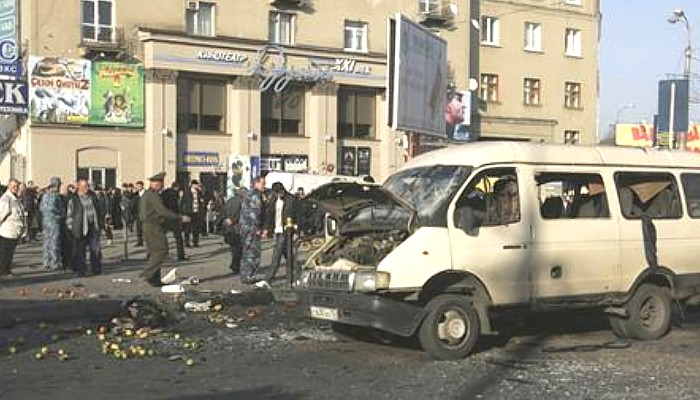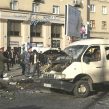
Suicide Bombings Part of Tactical Shift by North Caucasus Rebels
Publication: Eurasia Daily Monitor Volume: 6 Issue: 170
By:

In recent months attacks by insurgents in the North Caucasus have risen in intensity. More ominously, however, the range of targets -as well as the style of attacks- appears to demonstrate a newfound tactical capability which challenges the April announcement by the federal authorities that the counter-terrorist operation in Chechnya had ended. Largely overlooked at the time, a video statement was issued in April by Doku Umarov -the leader of the Caucasus Emirate- announcing the revival of the Riyadh-us-Saliheyn, a unit of suicide bombers linked to the insurgency which had been disbanded in 2006, at the behest of Umarov’s predecessor Abdul Khalim Sadulayev (www.kavkazcenter.com, July 7, 2006).
Umarov’s video address marked a tactical shift by the separatists, which had its roots in late 2008. On September 30, a suicide attack directed against the Ingush Interior Minister, Musa Medov, took place (North Caucasus Weekly, October 3, 2008). The attack mirrored an earlier bombing in April 2004, when a vehicle-borne explosive was used in an attempt to assassinate the then Ingush President, Murat Zyazikov. Zyazikov survived the 2004 attack, as did Medov in 2008, but the revival of targeted assassination using suicide terrorism signaled a clear tactical shift by the leadership of the Caucasus Emirate. In Ingushetia, heavy-handed security measures by the federal authorities, coupled with inter-clan rivalries, corruption and poverty meant that unabated lawlessness as well as rebel activity had increased. The federal authorities responded by sending more troops and police units to Ingushetia, replacing the incumbent President Zyazikov with Yunus-Bek Yevkurov in November 2008.
At around the same time, Umarov signaled that the insurgency maintained a credible military presence, although he indicated that financial difficulties had hindered its ability to mount sustained attacks in Chechnya proper in 2008. However some notable attacks did occur, including a suicide attack by two bombers against a federal military base in Vedeno in August 2008. Then, on November 6, a female bomber detonated explosives in a local taxi-van, killing over a dozen people in the North Ossetian capital, Vladikavkaz. Even though no claims of responsibility were issued at the time, those two attacks, coupled with the attack on Medov, indicated that a jamaat in Chechnya and the Ingush jamaat had once again resorted to the use of suicide terrorism.
According to the separatists, confirmation of this tactical shift came in 2009 when Umarov issued a statement indicating that Vladikavkaz was considered part of the operational zone of the Ingush jamaat, led by Emir Magas (Akhmed Yevloyev) (www.kavkazcenter.com, May 27). In an earlier statement Umarov indicated that the Riyadh us-Salihyen, which was now referred to as a military jamaat in its own right, had been revived, and was responsible for the 2008 suicide attacks. Umarov also indicated that further attacks would follow as part of a "year of offensive" (www.kavkazcenter.com, May 17).
So far, at least six attacks have followed the announcement by Umarov. The first came when a car bomb was driven into the motorcade of the newly installed Ingush President on June 21. The attack killed a number of bodyguards and badly wounded Yevkorov himself. This was followed, on July 26, by an attack by a lone bomber at a concert hall in Grozny. That attack killed a number of senior police officials (Interfax, July 26). The two attacks indicated that the tactical shift announced earlier in the year had become a reality. The targets, as well as the audacious well-planned nature of the attack in Chechnya proper, and the attack on the Ingush presidential motorcade -which was later claimed on behalf of the Riyadh us-Salihyen in a statement by Umarov- were coordinated attempts to attack the federal administrations in Chechnya and Ingushetia (www.kavkazcenter.com, September 1).
The next attack conducted by the Ingush jamaat was directed against the district headquarters of the police in Nazran. On August 17, attackers drove a minivan into the court yard of the police compound, detonating explosives (www.kavkaz-uzel.ru, August 24). The resulting explosion destroyed the building, killed over twenty policemen and wounded over a hundred. It was the largest single attack by the rebels since 2005, and was quickly claimed as an "act of sabotage" as part of wave of terrorism in a statement posted on a rebel website (www.kavkazcenter.com, August 21). This was followed by the rebel website releasing video footage of the attack. The footage was accompanied by an announcement that the young ideologue and convert, Said Buryatsky, who aligned himself with the rebel movement in 2008, had martyred himself in the attack (www.kavkazcenter.com, August 26). Although it led to much speculation, the statement indicating that Buryatsky was driving the minivan was later retracted, and declared as an administrative error, in a statement posted on another website.
Two further attacks occurred in Grozny on August 21 when coordinated bomb attacks -by suicide attackers using bicycles- were detonated near police officers on two streets in Grozny. Another suicide attack occurred shortly afterwards in Chechnya on August 25. A male bomber detonated explosives next to a group of policemen, killing four and wounding another in Mesker-Yurt. Interior ministry officials announced that the alleged attacker was Magomed Shakhidov, a member of Khusein Gakayev’s jamaat (www.kavkaz-uzel.ru, August 25). Three days later news reports indicated that two other members of the Gakayev jamaat had been surrounded in a residential block near Shali (ITAR-TASS, August 28). They detonated explosives, killing themselves and wounding three police officers.
It appears that the suicide attacks in Chechnya in late 2008 and 2009 were led, in part, by Gakayev’s jamaat. Federal authorities linked him to the concert hall and Mesker-Yurt suicide attacks (ITAR-TASS, August 28). This wave of attacks, along with the other attacks organized by the Ingush jamaat in Nazran and North Ossetia in 2008 and 2009, feed into a broader tactical shift by the leadership of the Caucasus Emirate, once again stretching the ability of federal forces to counter a new generation of rebel fighters in the Islamist insurgency.




